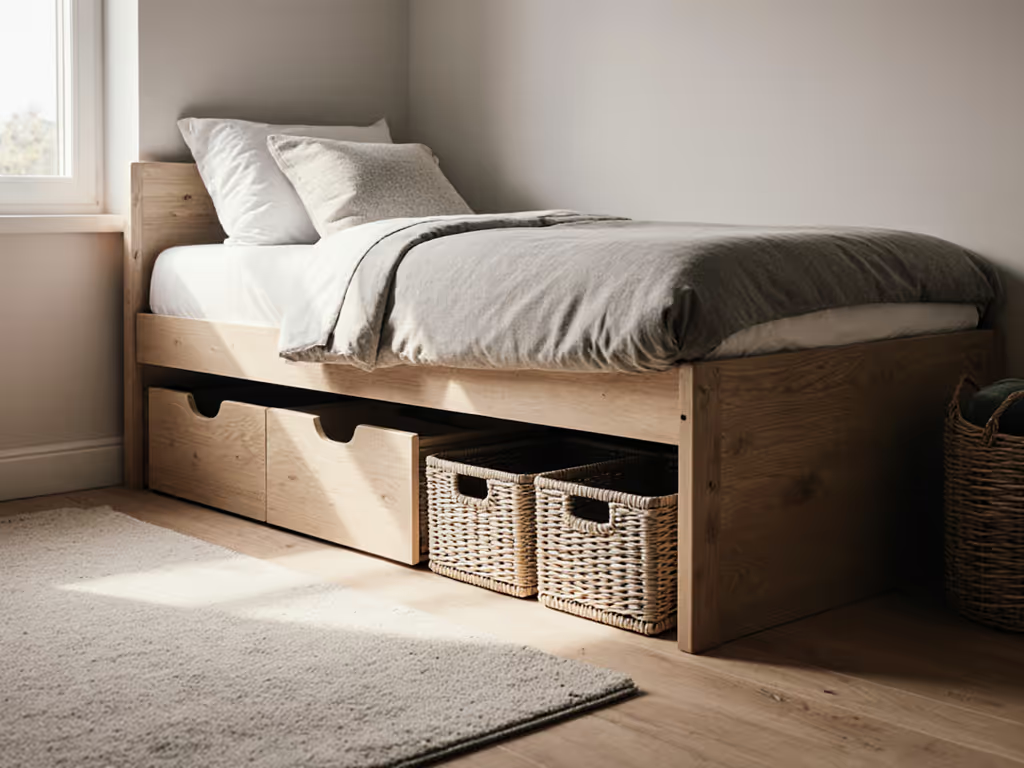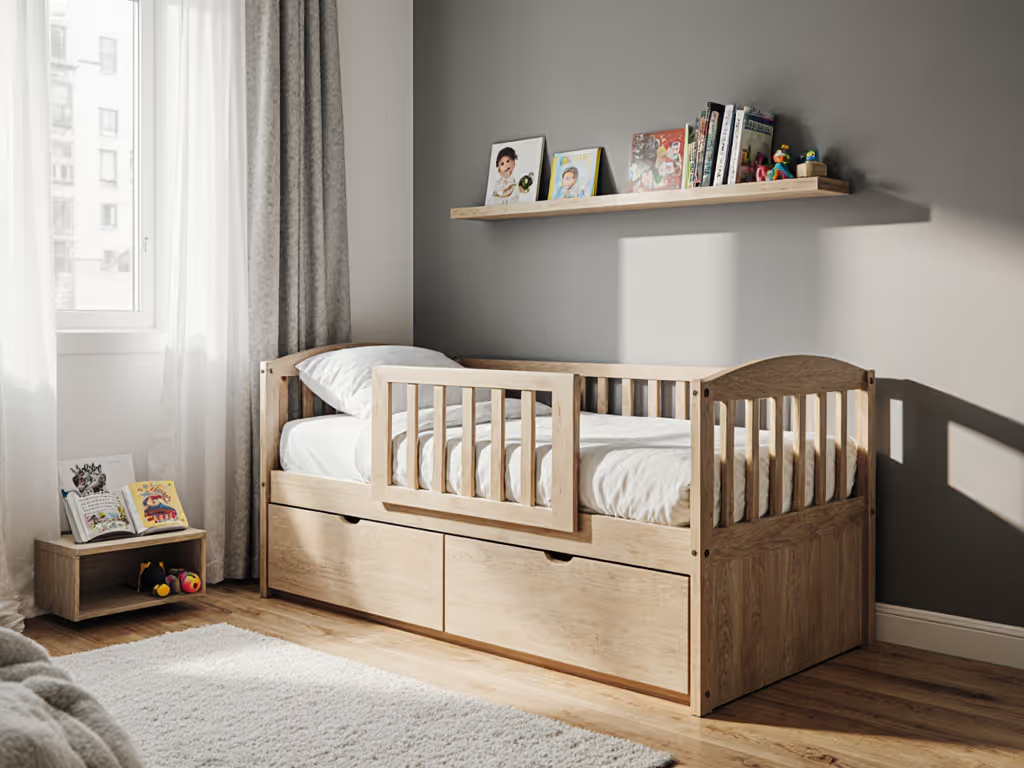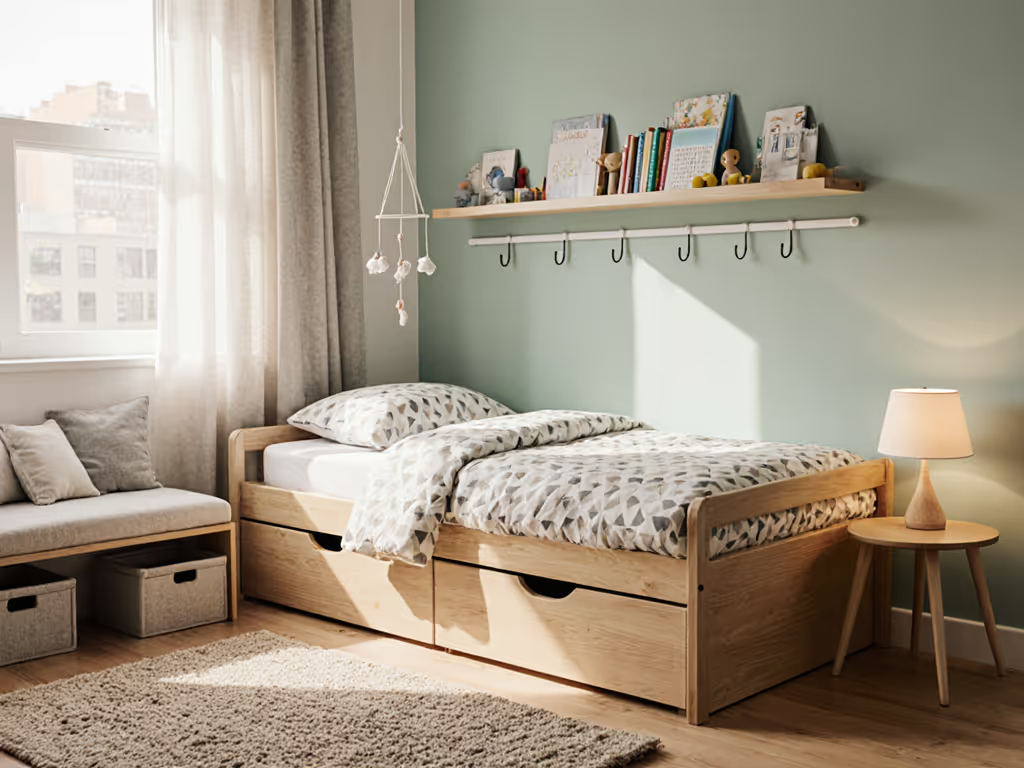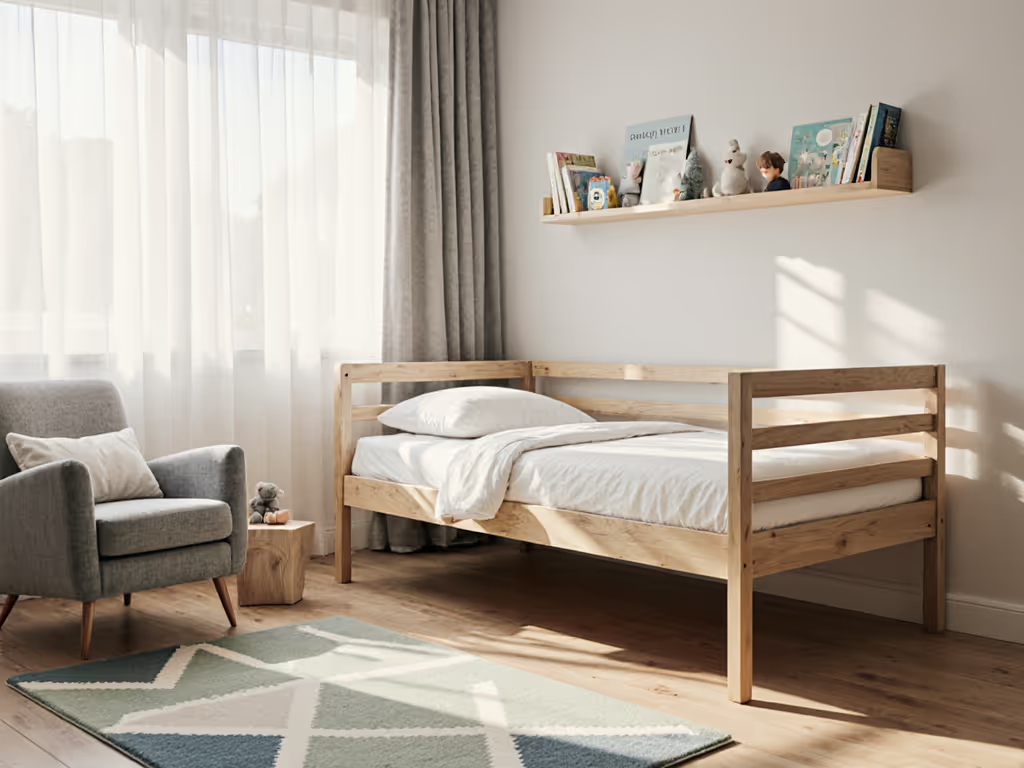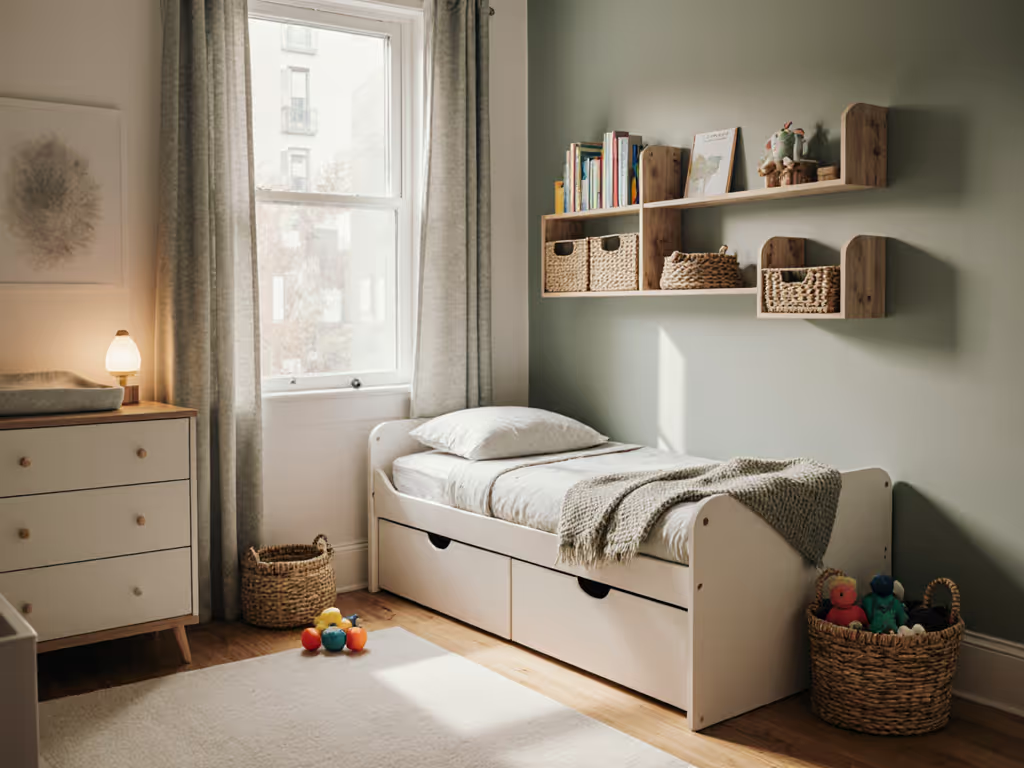
7 Smart Small Space Sleep Solutions for Toddler Bedrooms
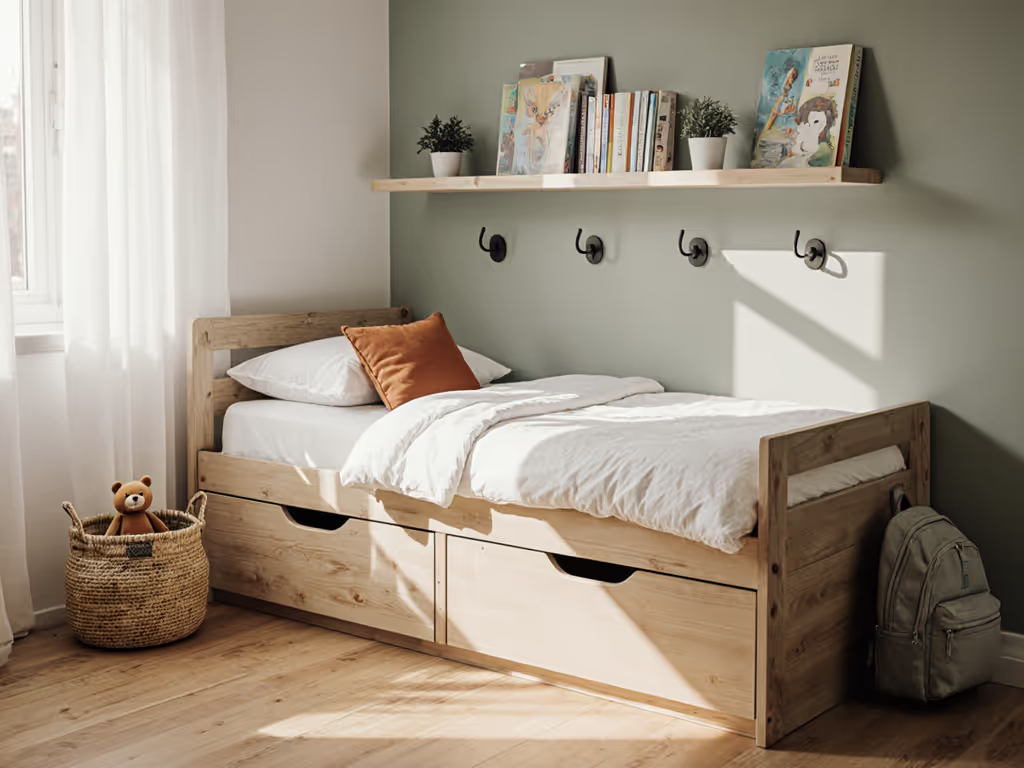
Did you know that nearly 40 percent of American families are working with less than 150 square feet per child in their home? Small bedroom spaces can make arranging a toddler’s room feel overwhelming, especially when safety and comfort are top concerns. Smart choices in furniture and storage can transform even the tiniest area into a cozy, functional retreat that suits your growing child’s needs while keeping clutter—and worries—at bay.
Quick Summary
| Takeaway | Explanation |
|---|---|
| 1. Choose low-profile toddler beds | Select beds under 18 inches high for safety and minimal fall risks for toddlers. |
| 2. Opt for multi-functional furniture | Use furniture that adapts to your child's needs, maximizing small room space effectively. |
| 3. Utilize under-bed storage solutions | Implement shallow storage units to keep items organized without compromising safety. |
| 4. Install wall shelves securely | Use anchored wall shelves to store items safely and efficiently in limited space. |
| 5. Incorporate flexible sleep zones | Create individual sleep areas with dividers to provide personal space in shared bedrooms. |
1. Choose Compact and Low-Profile Toddler Beds
Transitioning your toddler from a crib to their first big kid bed requires strategic thinking about space and safety. Compact and low-profile toddler beds offer an intelligent solution for parents navigating small bedroom environments.
The U.S. Consumer Product Safety Commission emphasizes that toddler beds should be low to the ground to minimize potential injury risks. By selecting a bed closer to floor level, you significantly reduce the chance of fall-related accidents. Low beds provide an additional layer of protection for curious and sometimes unsteady young sleepers.
Safety considerations for compact beds include:
- Guardrails that securely prevent unexpected rolling
- Sturdy construction with minimal height
- Smooth rounded edges to prevent potential bumps
Parents with limited square footage will appreciate how these space-efficient beds maximize room functionality. A low-profile design allows more floor space for play areas, storage, or additional furniture. Some models even feature built-in storage drawers underneath, creating a multifunctional sleeping solution that grows with your child.
When shopping, measure your available space carefully and look for beds specifically designed for small rooms. Aim for models no taller than 18 inches from floor to mattress top, which provides optimal safety while maintaining a comfortable sleeping environment for your toddler.
2. Opt for Multi-Functional Furniture Pieces
Small bedrooms demand creative solutions that maximize every square inch of available space. Multi-functional furniture offers smart design that adapts to your toddler's changing needs while keeping their sleeping area efficient and organized.
These innovative furniture pieces go beyond traditional single-purpose items by integrating multiple functions into one compact design. A bed with built-in storage drawers or a convertible frame that transforms as your child grows represents an intelligent investment for parents managing limited living spaces.
Key benefits of multi-functional furniture include:
- Reduced clutter and improved room organization
- Cost effective long term investment
- Adaptable designs that grow with your child
- Maximized use of limited bedroom space
The Consumer Product Safety Commission recommends carefully selecting furniture that meets safety standards. When choosing multi-functional pieces, prioritize sturdy construction and smooth edges. Look for designs with secure storage compartments that prevent pinching or trapping hazards.
Consider options like trundle beds that slide underneath when not in use, loft beds with study areas beneath, or frames with integrated shelving. These creative solutions transform small bedrooms from cramped spaces into functional sleep and play environments that support your toddler's developmental needs.
3. Maximize Under-Bed Storage Options
Every square inch counts when designing a toddler bedroom in a small space. Under-bed storage transforms unused space beneath your child's bed into a strategic organizational solution that helps keep rooms tidy and functional.
The Consumer Product Safety Commission emphasizes the importance of maintaining bed structural integrity while implementing storage solutions. This means selecting storage systems that do not compromise the bed's stability or safety standards. Carefully chosen under-bed storage can provide valuable space without risking your toddler's sleeping environment.
Smart storage strategies include:
- Shallow rolling drawers with secure closures
- Fabric containers with tight fitting lids
- Plastic bins with childproof latches
- Low profile storage solutions that fit flush with bed frame
When implementing under-bed storage, prioritize safety and accessibility. Choose containers with smooth edges and avoid storing items that could pose potential hazards. Opt for clear or labeled containers to help your toddler learn organization skills while keeping seasonal clothing, extra bedding, or quiet play items neatly contained.
Pro tip for parents: Select storage containers no taller than 6 inches to ensure they slide easily under low profile toddler beds. This approach maximizes available space while maintaining a clean and organized bedroom environment that grows with your child's changing needs.
4. Use Vertical Space with Wall Shelves
When floor space is limited, looking up becomes your best strategy for creating functional storage in a toddler bedroom. Wall shelves transform empty vertical areas into smart organizational solutions that keep rooms tidy and maximize available square footage.
The Consumer Product Safety Commission strongly recommends securing wall shelves properly to prevent potential tip over accidents. This means using robust wall anchors and mounting hardware specifically designed to support the weight of stored items. Careful installation is key to creating a safe storage environment that protects both your child and their belongings.
Safety considerations for wall shelves include:
- Install shelves high enough to be out of toddler reach
- Use heavy duty wall anchors appropriate for wall material
- Place lightweight soft items on upper shelves
- Keep heavier objects on lower mounted shelves
When selecting wall shelves for a toddler room, prioritize rounded edges and smooth surfaces. Consider floating shelves with hidden mounting brackets that create a clean modern look while minimizing potential sharp corners. Materials like wood or soft coated metals work best for creating a child friendly aesthetic that grows with your little one.
Remember that wall shelves are not just storage solutions but also opportunities for creating visual interest. Arrange books stuffed animals or small decorative items to personalize the space while maintaining a functional and safe environment for your curious toddler.
5. Create Flexible Sleep Zones in Shared Rooms
Sharing a bedroom can be challenging for toddlers, but strategic design can transform shared spaces into comfortable personal sanctuaries. Flexible sleep zones help children maintain a sense of individual space while maximizing limited square footage.
The Consumer Product Safety Commission highlights the importance of creating safe sleeping arrangements in shared rooms. This means carefully planning bed placement, ensuring appropriate guardrails, and maintaining clear pathways to prevent potential accidents.
Key strategies for creating effective sleep zones include:
- Using room dividers or curtains for visual separation
- Selecting complementary but distinct bedding for each child
- Establishing clear personal storage areas
- Implementing consistent bedtime routines
Visual boundaries play a crucial role in helping toddlers feel secure in shared spaces. Consider using area rugs, portable screens, or strategically placed furniture to define individual sleep areas. Color coding or selecting unique themes for each child's space can help create a sense of personal identity within a shared environment.
Practical tip for parents: Involve your children in designing their shared space. Let them choose small personal decorations or bedding elements that make their sleep zone feel special. This approach not only creates a more harmonious room but also helps children develop a sense of ownership and respect for shared living spaces.
6. Select Foldable or Convertible Bedding
When square footage is precious, foldable or convertible bedding becomes a game changing solution for parents managing small bedroom spaces. These innovative sleep solutions offer flexibility that adapts to your toddler's changing needs while maximizing available room.
The Consumer Product Safety Commission emphasizes the critical importance of selecting bedding that meets rigorous safety standards. This means choosing convertible options with secure locking mechanisms that prevent accidental folding during sleep and provide stable support for your growing child.
Key features to look for include:
- Sturdy frame construction
- Easy conversion mechanisms
- Smooth edges without pinch points
- Lightweight yet durable materials
- Multiple configuration options
Convertible bedding goes beyond simple space saving. These intelligent designs can transform from cribs to toddler beds to junior beds, growing alongside your child and providing long term value. Some models even include built in storage or can be configured as daytime seating areas, making them incredibly versatile for compact living spaces.
Practical tip for parents: Before purchasing, test the conversion mechanism in person. Ensure you can easily adjust the bed without complex tools or complicated procedures. Look for models with clear instructions and simple transformation processes that you can manage quickly and safely.
7. Incorporate Safety Features for Small Spaces
Navigating safety in compact toddler bedrooms requires strategic planning and thoughtful design. Safety features become even more critical when working with limited square footage, where every design choice impacts your child's protection.
The Consumer Product Safety Commission provides clear guidelines for creating secure sleeping environments. In small spaces, this means carefully considering furniture placement, eliminating potential hazards, and implementing protective measures that keep curious toddlers safe without feeling restrictive.
Essential safety strategies include:
- Anchoring furniture to walls to prevent tipping
- Covering electrical outlets with childproof plugs
- Removing cords from window treatments
- Using corner guards on sharp furniture edges
- Installing safety gates at room entrances
When arranging furniture in tight spaces, maintain clear pathways and ensure that beds are positioned away from windows, radiators, and electrical outlets. Use soft padded mats or rugs around sleeping areas to minimize potential injury from accidental falls. Consider wireless lighting solutions and wall mounted fixtures that eliminate trailing electrical cords.
Practical tip for parents: Conduct a thorough safety audit of the room from a toddler's eye level. Get down on your knees and scan the environment for potential risks. This perspective helps identify hidden dangers that might not be immediately apparent from an adult's viewpoint.
Below is a comprehensive table summarizing the key strategies for optimizing small toddler bedroom spaces as discussed in the article.
| Strategy | Implementation | Benefits |
|---|---|---|
| Compact & Low-Profile Beds | Choose beds low to the ground with guardrails and rounded edges. | Increases safety and space efficiency. |
| Multi-Functional Furniture | Use beds with storage or convertible designs. | Reduces clutter and supports growth. |
| Under-Bed Storage | Implement shallow rolling drawers or fabric containers. | Maximizes space and maintains tidiness. |
| Wall Shelves | Install robust anchors and place lightweight items high. | Utilizes vertical space and adds visual interest. |
| Flexible Sleep Zones | Use room dividers and coordinated bedding for shared rooms. | Establishes personal space and harmony in shared environments. |
| Foldable or Convertible Bedding | Select secure, easy-to-use models. | Provides long-term value and adaptability. |
| Safety Features | Anchor furniture, cover outlets, use corner guards. | Enhances overall safety and minimizes risks. |
Discover Space-Smart Toddler Bed Solutions for Your Little One
Every parent knows the challenge of creating a safe and comfortable bedroom for a toddler when space is limited. From selecting a compact, low-profile bed to maximizing storage and ensuring essential safety features, your goal is to build a space where your child can rest, play, and grow happily. The article's focus on smart, small space sleep solutions highlights exactly what you need when every square inch counts.
Explore expert guidance on choosing beds that prioritize safety, durability, and space efficiency at City Toddler Beds. Whether you want practical tips for under-bed storage, multi-functional furniture, or converting cribs into toddler beds, our comprehensive resources help you tackle these common parenting pain points with confidence. Don’t wait to transform your toddler’s bedroom into a comfy, secure oasis. Start now by visiting City Toddler Beds for trusted advice and step-by-step insights designed for first-time parents navigating the world of toddler bed solutions.
Frequently Asked Questions
How do I choose the right compact toddler bed for a small room?
Selecting the right compact toddler bed involves measuring your available space and ensuring the bed is no taller than 18 inches from the floor to the mattress top. Prioritize options with guardrails and sturdy construction for optimal safety.
What are some effective multi-functional furniture ideas for toddler bedrooms?
Consider incorporating furniture that serves multiple purposes, such as beds with built-in storage drawers or convertible frames. Look for designs that adapt as your child grows, which can help reduce clutter and maximize floor space.
What are some safe under-bed storage options for toddler bedrooms?
Choose shallow rolling drawers, fabric containers with secure lids, or plastic bins with childproof latches for under-bed storage solutions. Ensure containers are no taller than 6 inches to slide easily under low-profile beds while keeping the space organized.
How can I create flexible sleep zones in shared toddler bedrooms?
Implement room dividers or curtains to visually separate spaces for each child while selecting distinct bedding for personal touches. Establish clear storage areas and routines to maintain harmony and a sense of individual space.
What safety features should I incorporate in a small toddler bedroom?
Ensure all furniture is anchored to the walls to prevent tipping, cover electrical outlets, and remove trailing cords from window treatments. Use corner guards on sharp edges and establish clear pathways to enhance safety within the compact environment.
How do I select convertible bedding for a small space?
Choose convertible bedding with sturdy construction and secure locking mechanisms that prevent accidental folding. Look for designs that can easily transition from cribs to toddler beds, enhancing versatility as your child grows.

